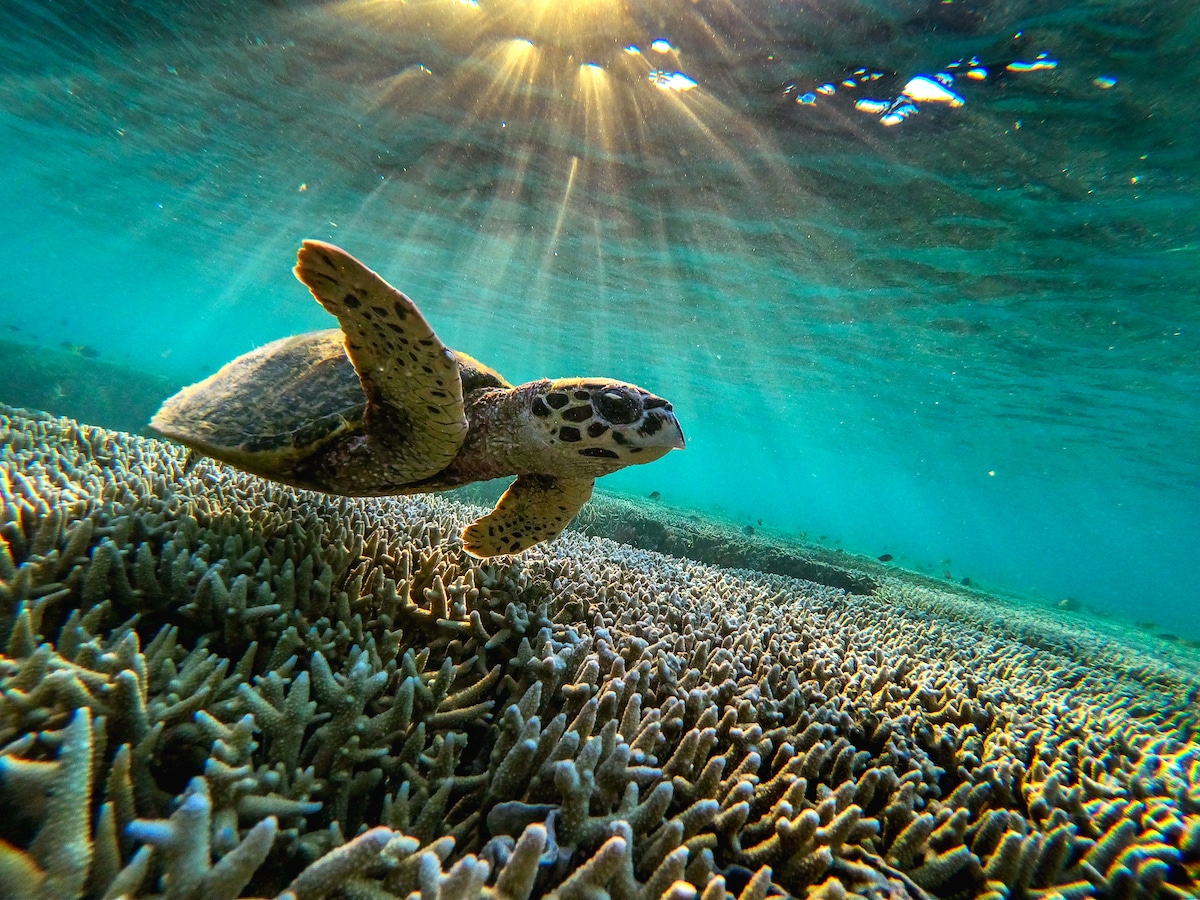Products You May Like
Quick Key Facts
- Marine environments cover 70% of Earth.
- Over 50% of oxygen on the planet comes from oceans.
- Top threats to oceans include pollution, noise and climate change.
- Plastic pollution is expected to outweigh all fish in the oceans by 2050.
- Prescription drugs, agricultural runoff, industry discharge and even sunscreen chemicals can alter the chemistry of marine ecosystems.
- Overfishing puts marine species populations at risk, with sharks and rays especially vulnerable.
- The 2010 Deepwater Horizon spill, the biggest oil spill in U.S. history, is still being remedied today.
- The Gulf of Mexico is a major dead zone, where marine life can no longer live due to lack of oxygen.
- The Great Pacific Garbage Patch contains about 1.8 trillion pieces of plastic, along with other types of waste.
- Some of the most threatened marine life include sea turtles, dugongs, North Atlantic right whales and coral reefs, especially in the Great Barrier Reef.
Why Threats to Marine Environments Matter
When you think of the oceans, you might recall standing on the shoreline as a child, looking out in wonder at the vast blue that extended into the skyline. Marine environments deserve the fascination we place upon them. Oceans cover over 70% of Earth, and with that much coverage, they help regulate climate, store carbon and even generate more than half of the oxygen on the planet.
But our oceans are facing a number of serious threats that put aquatic life and even humans at risk. You’ve seen the images: sea turtles eating plastic, a seahorse tail wrapped around a cotton swab, a shimmering dark spot spreading across the water after an oil spill. From rising sea levels to plastic pollution to toxic waste dumping, human activity is threatening the health of marine environments and, in turn, putting humans around the world in danger.
Top Threats to Marine Life and Oceans
Unfortunately, one could write up pages upon pages of threats to our oceans, but there are several top contenders that need immediate attention. Here are some of the top threats to marine environments and aquatic life.
Pollution
It’s no secret that we are polluting our oceans at an alarming pace. Whether it’s the infamous plastic straws or a massive oil spill, pollution is a top threat that comes in many different forms. Plastic is a major ocean threat, but other forms of pollution, like chemicals from popular sunscreens or prescription drugs, are also problematic for plants and animals in the oceans.
In addition to becoming entanglement and choking hazards, pollution can also shift marine chemistry. These pollutants contribute to ocean acidification, which can lead to coral bleaching or affect molluscs’ development.
Plastic Pollution
There are an estimated 75 million tons to 199 million tons of plastic in the oceans today, and a 2015 study found that up to 12.7 million metric tons of plastic waste enters the oceans each year. But this annual figure is expected to nearly triple by 2040. Even worse, current projections show that there will be more plastic by weight than fish in the oceans by 2050.
All of this ocean plastic has even led to the newly defined Plastisphere, as plastics floating in the ocean attract single-cell organisms like bacteria and algae, creating new, small ecosystems within the marine environment.
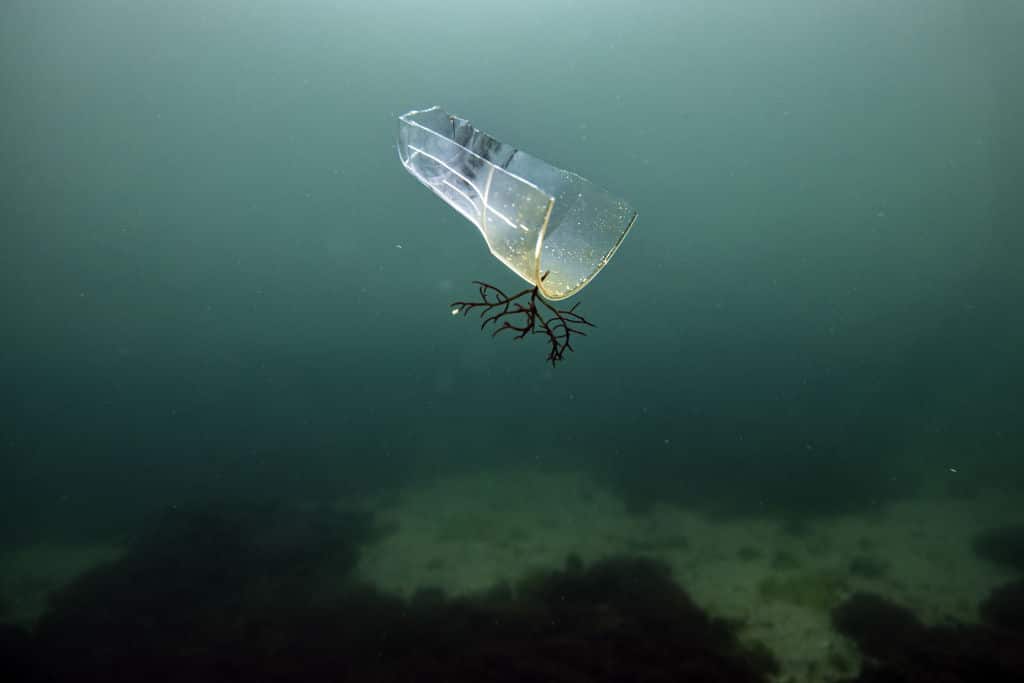
Agricultural Runoff
From fertilizers to pesticides, agriculture is a top polluter for water sources, including the oceans. Precipitation carries treated soil, manure, fertilizers, pesticides, and other chemicals away, and they runoff into waterways and ultimately, marine environments. These pollutants prevent sunlight from reaching plants, like carbon-sequestering seagrasses, block fish gills, and contribute to ocean deoxygenation, which can kill off marine life while allowing harmful algal blooms.

Sunscreen Chemicals
Like agricultural runoff, chemicals in sunscreen may protect your skin from UV rays, but they can also wash away into the marine environment off of your skin when you’re taking a swim or catching some waves on a surfboard. (Of course, you should still wear sunscreen when heading to the beach, but watch out for harmful ingredients and know how to identify safe sunscreens.)
Many people have heard about the detrimental effects sunscreen chemicals have on coral reefs, but these chemicals contribute to more than coral bleaching. Sunscreen chemicals have been found accumulating on seagrasses in the Mediterranean, and these seagrasses are an important carbon sink. Sunscreen chemicals can lead to defects in mussel, sea urchin, and coral young as well as cause fertility and reproductive challenges in fish.
Some of the most harmful sunscreen chemicals include zinc oxide, titanium dioxide, oxybenzone, octinoxate, homosalate, avobenzone, octocrylene, octisalate, 4-methylbenzylidene camphor, methyl paraben, ethyl paraben, butyl paraben, benzyl paraben, and propyl paraben.
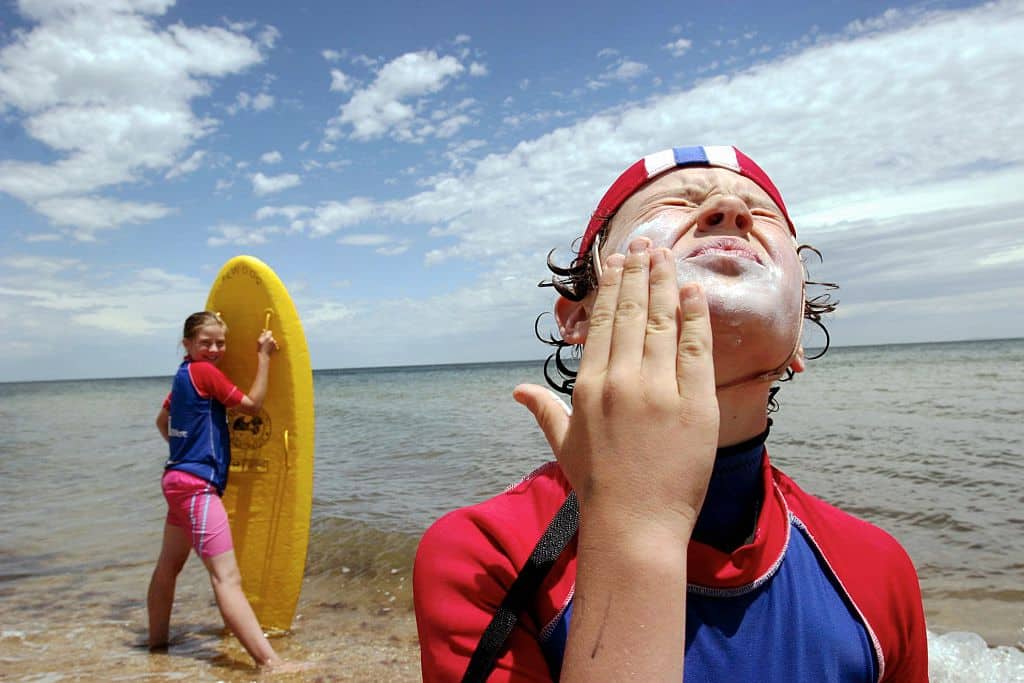
Prescription Drugs
Modern medicine is crucial to healthy humans, but pharmaceuticals are becoming a growing concern in marine environments. Taking prescription drugs as intended and properly disposing of unused medications is important. As people flush extra prescription drugs or wash them down the sink, the contaminants can make their way into local waterways. The contaminants can also be present in human excrement after taking the medications. But one study outlines another source of this pollution: discharge from pharmaceutical manufacturing facilities. Many places have water treatment facilities that cannot treat the compounds of the drugs, so these contaminants can get through the filters.
A recent study conducted over the course of three years found as many as 17 prescription drugs present in a single bonefish and 58 medications among 93 bonefish, outlining the severity of the issue.
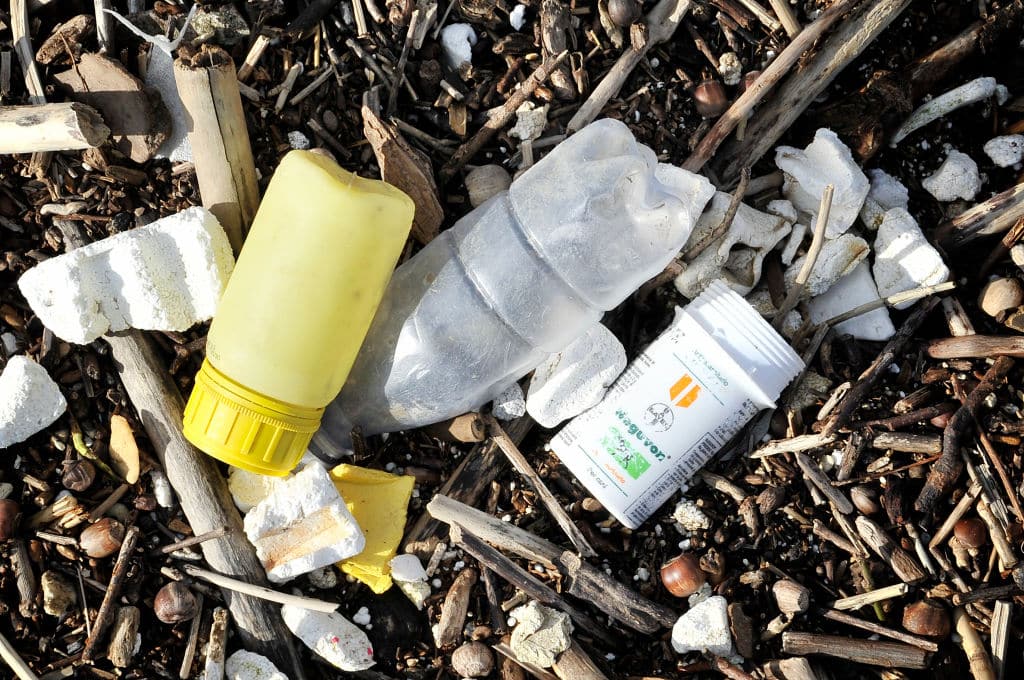
Industry Discharge
In addition to pharmaceutical manufacturing facilities’ discharge, other industries also release waste into waterways and/or oceans and contribute to more environmental pollution. Facilities discharge chemical-laden wastewater, which can then alter the ocean environment. Chemicals, heavy metals, sewage, and other waste may contribute to health defects and reproductive issues in marine life and can encourage algal blooms.
Radioactive waste from nuclear power plants is also an ocean pollutant. While there are protocols meant to contain radioactive waste, even waste dumped decades ago will remain radioactive and dangerous for many years.
Another major industrial discharge is the toxic DDT, a pesticide banned in the U.S. in 1972. Companies used to dump barrels of DDT into the oceans, but it wasn’t clear just how massive the problem was until 2021 when up to 500,000 barrels were discovered off the coast of Southern California. DDT leaks from the barrels and causes harm to local wildlife. Chemical dumping has been linked to high cancer rates in sea lions and blood contamination in critically endangered California condors.

Overfishing
Billions of people around the world rely on seafood for protein, and many communities use fishing as a primary source of income. But commercial fishing and illegal fishing are threatening many of the ocean’s unique species. Overfishing is when crews catch more fish at a time than can be recovered through reproduction, leaving a depleted population. World Wildlife Fund reported that global overfished stocks have tripled in just 50 years.
Sharks and rays are particularly vulnerable, with over one-third of shark, ray and chimaera species at risk of extinction due to overfishing. Atlantic bluefin tuna and Southern bluefin tuna are also dangerously overfished.
Aside from threatening marine species, overfishing may also contribute to more toxins in seafood as larger fish, like tuna and cod, turn to high-mercury prey. This issue is further exacerbated by climate change, which threatens oceans in many ways.
Military Sonar
For some marine life, military sonar used for navigating, training and testing can disrupt their behaviors, leading to injury or even death. In a military report obtained by the journal Nature, the UK military found that sonar would cause whales to stop foraging for food and vocalizing. Depending on the whale’s initial reaction to the sonar, it could lead the whale to stop feeding and eventually starve. Mass strandings for several species of whales and dolphins have also been linked to military sonar.
Deep-Sea Mining
Mining in the deep seas can be just as detrimental as mining on land. This activity involves dredging the bottom of the ocean over 200 meters deep and extracting minerals such as manganese, nickel, cobalt, zinc, gold and copper.
Removing this layer of seabed can destroy long-formed habitats for coral, sponges and other marine life. Mining around hydrothermal vents also destroys these habitats and will impact the unique creatures — like crabs, sea stars and sea anemones — that call these spaces home.
As the deep-sea mining occurs, it stirs up potentially toxic sediment clouds that may impact nearby sea life or could even travel tens of thousands of square kilometers farther than the mining sites.

Oil Spills
Time and time again, a massive oil spill makes the news, with images of marine life, like sea turtles or pelicans, covered in oil. This can kill the animals either by restricting movement or through oil toxicity. Even with a rapid cleanup response, many affected animals cannot be found or are too large to recover.
The biggest oil spill in U.S. history was the 2010 Deepwater Horizon spill. The drilling platform, located in the Gulf of Mexico, exploded, causing 11 deaths. Then, over the course of three months, the site leaked about 134 million gallons of oil, and the area is still under restoration efforts today.

Climate Change
Oceans are an important carbon sink and can trap heat from the increasing emissions, but that means the oceans are getting warmer. In addition to higher temperatures impacting marine life, these warmer waters can also contribute to stronger and/or more frequent hurricanes, threatening human lives and countries’ economies.
Climate change is also contributing to sea level rise as glaciers melt. According to World Meteorological Organization, oceans are rising at a high of about 4.5 millimeters per year. Sea level rise also contributes to worsening tropical storms and leaves coastal communities vulnerable to erosion, landslides, floods and life-threatening storm surges.
As oceans absorb more carbon emissions, the ocean becomes more acidic. Ocean acidification can weaken coral reefs and impact development of marine life. Some shelled organisms even dissolve in areas of high acidification, ultimately reducing biodiversity and impacting entire food webs.
Ocean Noise
Human activities, like military training, deep-sea mining, commercial fishing, shipping, and oil drilling, produce noises that interfere with marine life’s ability to listen for natural sounds of the ocean. Many marine species rely on their sense of hearing or echolocation to navigate the open seas, find mates, reproduce, forage and dodge predators. Ocean noise pollution can negatively impact animals’ behaviors and can have serious risks, including death.
Hotspots: Most Threatened Areas of the Ocean
While threats stretch to every corner of the ocean (even Point Nemo, the most remote part of the ocean, is plagued by plastic waste), there are a few areas especially vulnerable to a high number of threats. From dead zones in the Gulf of Mexico to coral bleaching in the Great Barrier Reef, here are the most threatened parts of oceans around the world.
Gulf of Mexico
The site of the biggest oil spill in U.S. history, the Gulf of Mexico is also vulnerable to agricultural and urban runoff that create a “dead zone” where marine life may not survive due to a lack of oxygen. The Gulf of Mexico Hypoxic Zone (or Dead Zone) spans 6,334 square miles as of 2021 and is the second-largest dead zone in the world. This region has also seen harmful algal blooms and devastating hurricanes in recent years due to pollution and climate change.
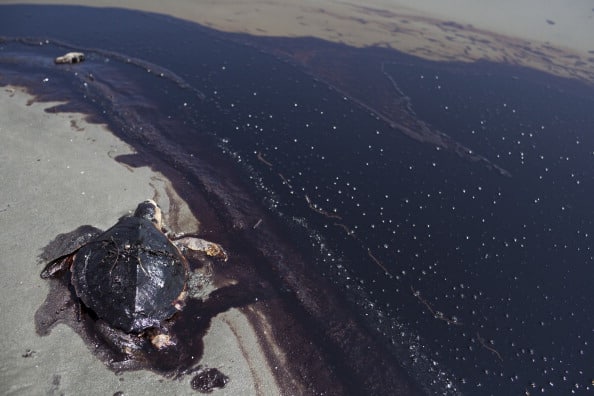
Great Pacific Garbage Patch
Rotating ocean currents, called gyres, pull pollution into patches in their centers. Here, trash spreads across the water surface and deep into the ocean and includes microplastics to massive pieces of garbage. Up to 80% of litter in the ocean is plastic. There are five major gyres on Earth, but the largest and most well-known is the Great Pacific Garbage Patch. There is an estimated 1.8 trillion pieces of plastic in the Great Pacific Garbage Patch.
Aquatic animals face many life-threatening risks in these gyres, including in the Great Pacific Garbage Patch. Sea life can become entangled in discarded fishing nets, often called “ghost nets” or “ghost gear,” or they may ingest the plastics and either choke or fill their stomachs with litter and stop eating food.
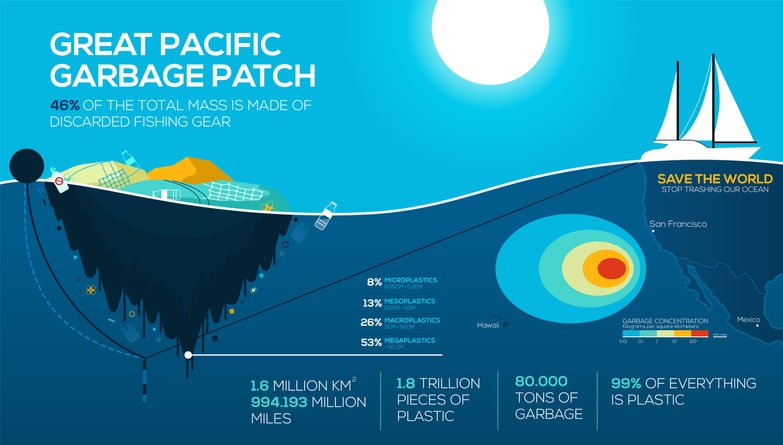
Great Barrier Reef
A UNESCO World Heritage Area since 1981, the Great Barrier Reef is rich in biodiversity — for now. It has long been home to vibrant coral reefs and is the unique habitat for endangered green turtles and vulnerable dugongs.
Warming waters and agricultural runoff have contributed to mass coral bleaching events in the Great Barrier Reef. While bleaching isn’t a death sentence, it does weaken the coral and make them more vulnerable over time.
Pollution can also prevent enough sunlight from reaching marine plants, like seagrasses, which are an important carbon sink and a food source for marine animals. Coastal development and illegal fishing are also threatening the Great Barrier Reef.

Most Threatened Marine Life
Many species are impacted by ocean threats, whether it be noises that disrupt feeding and mating behaviors or pollution that becomes choking and entanglement hazards. But some species are now vulnerable to extinction after decades of facing these threats.
North Atlantic Right Whales
The North Atlantic right whale species is found primarily in Atlantic coastal waters. North Atlantic right whales are listed as endangered under the Endangered Species Act. Estimates say there are fewer than 350 left of the species and fewer than 100 females who are able to reproduce. Fishing gear entanglements are one of the top threats to this species, but vessel strikes, ocean noise and climate change are all contributing to the declining population.

Sea Turtles
Most of the seven species of sea turtles are now considered endangered, including green, hawksbill, loggerhead, leatherback and olive ridley sea turtles. The turtles have long been vulnerable to poaching, but habitat destruction, especially for nesting sites, from coastal development has also threatened these creatures. Entanglements in fishing gear is another major threat for sea turtle species. Climate change has influenced the sex of hatching sea turtles, as this process depends on the temperature of the incubation site. This creates lower genetic diversity.

Vaquitas
Vaquitas are a critically endangered species and the rarest marine mammal on Earth. Scientists estimate that only about 10 vaquitas remain on the planet. Their numbers are plummeting due to entanglements from illegal fishing gear. From 2011 to 2016, the population dropped 90%, primarily because of entanglements in gillnets and becoming bycatch. Water contamination and decreased flow of the Colorado River impacting the vaquitas’ food source are also factors.
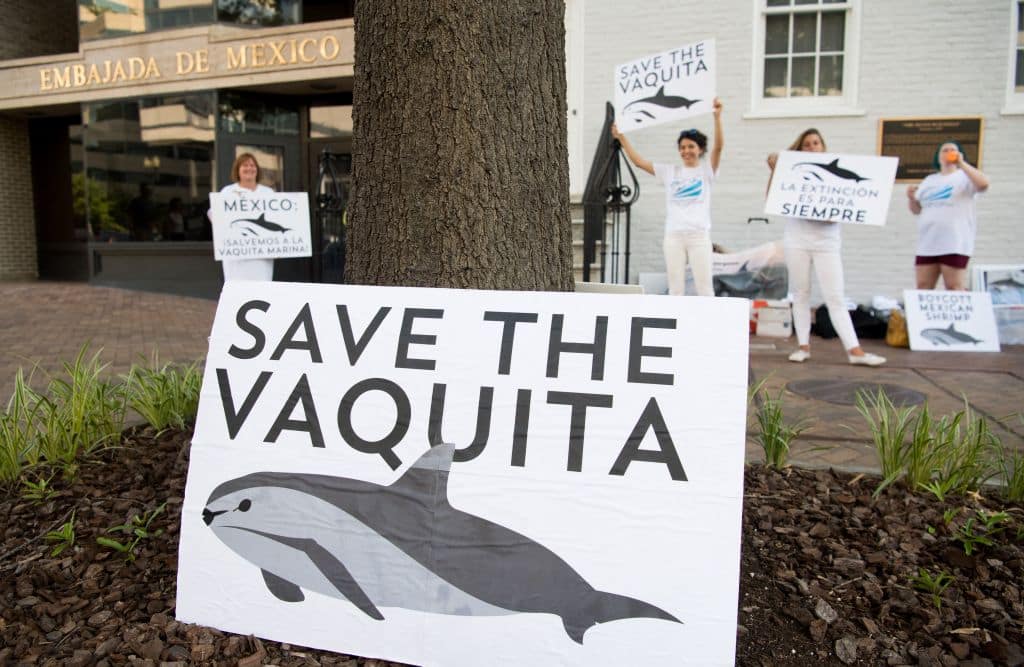
Whale Sharks
The largest shark and fish alive on Earth today, whale shark populations are declining in some regions. The species is considered endangered by the International Union for Conservation of Nature (IUCN). Pollution, loss of food from bycatches, fisheries and vessel strikes are some of the top threats to these gentle giants, which are filter feeders that live off of plankton and krill.

Southern Bluefin Tuna
Overfishing has driven the Southern bluefin tuna species to become listed as critically endangered. They are sought after particularly for sashimi, and a single fish can sell for hundreds of thousands of dollars. Most Southern bluefin tuna are caught while young, then kept in underwater cages and fattened before being sold. It is estimated that with business as usual, the species will reach fewer than 500 mature individuals within 100 years.

Dugongs
A relative of the manatee, dugongs are a vulnerable species whose closest modern relative, the Steller’s sea cow, went extinct from hunting in 1768. Dugongs are also vulnerable to hunting, as their meat and oil are valuable. They feed primarily on seagrasses, which are impacted by pollution, algal blooms and climate change. Vessel strikes and entanglement are also risks to the species, which is deeply fragmented, further threatening the dugong.

Ocean Policy
There’s plenty of room for improvement globally for ocean policies, to say the least. In early 2022, the UN created a mandate to begin negotiating for a global plastics treaty for the first time to deal with the root issues of plastic pollution in the ocean and on land. Some governments are already making efforts toward marine conservation, and there are many major NGOs working to influence more ocean policies.
Government Response
Ocean policy tends to be neglected as globally, governments have not yet created any sort of system or process to make binding agreements or policies for oceans. Ocean policies are discussed at UN conventions, but actionable steps are rarely laid out. “Ocean governance” lacks any defined meaning or process that can make it a reality.
There is some hope, though. In 2018, 14 countries came together to form the High Level Panel for a Sustainable Ocean Economy for more sustainable ocean management. Some governments have also taken their own steps toward conserving marine environments. As of 2020, Marine Conservation Institute reports that the top 10 countries (with over 10,000 kilometers of coastal and ocean domains) for the largest percentage of marine protected areas are Palau, United Kingdom, Germany, Australia, Brazil, United States, Gabon, Poland, Mexico, Estonia, Nicaragua and Latvia. Over 80% of Palau’s coastal and ocean areas are designated marine protected areas.
NGO Policy Work
Fortunately for our oceans, there is no shortage of NGOs taking on the task of protecting marine environments. While there are many organizations doing great work, here are some efforts from top marine conservation-focused NGOs.
Greenpeace
Greenpeace’s marine conservation successes date back decades. One of its major wins was in 1978, when New Zealand banned commercial whaling with the Marine Mammals Protection Act following submissions from Greenpeace and other conservation organizations. In 2021, it helped stop a destructive fishmeal plant project in The Gambia.
Today, Greenpeace is campaigning to end deep sea mining globally and for a global treaty that could establish a large network of marine sanctuaries.
Oceana
Since 2001, Oceana has worked toward conserving and boosting ocean biodiversity. One key part of its mission is to advocate for science-based fishery management and secure policy victories. Some of its recent wins include a ban on shark fin imports and exports in Canada, major plastic reduction laws in California and New York, and an end to government-issued permits for seismic airgun blasting in the Atlantic Ocean.
Currently, Oceana is campaigning to save North Atlantic right whales from extinction, end misleading and false information in seafood labeling, and put a stop to offshore drilling off U.S. coasts.
Sea Shepherd Conservation Society
Sea Shepherd is dedicated to marine life conservation. It helps support developing governments in protecting waters from illegal fishing. In recent years, the organization has vessels, crew members and other tools for governments and has assisted in dozens of vessel arrests to protect marine life.
One of Sea Shepherd’s biggest campaigns is saving vaquitas from illegal fishing gear in the Vaquita Refuge in Mexico. The NGO has removed over 1,000 pieces of fishing gear from the protected area.
Ocean Conservancy
Ocean Conservancy has been fighting for marine environments since 1972 and now works globally for marine conservation and to support communities that depend on the ocean. Since its first cleanup event in 1986, the organization has cleaned over 345 million pounds of ocean pollution.
In addition to ocean cleanup, Ocean Conservancy is campaigning for environmental justice, ocean funding and policies, sustainable seafood and conserving particularly vulnerable regions, like the Arctic and the coasts of Florida.
Surfrider Foundation
Surfrider Foundation began in Malibu in 1984, and has since had over 800 victories for the ocean. It has established an Ocean Friendly Restaurants program to help consumers find restaurants that skip on single-use plastics. Its Blue Water Task Force tests nearly 500 beaches regularly to provide safe, healthy beaches to the public.
The foundation is currently working with the government on passing a Break Free From Pollution Act to minimize waste that ends up in the ocean along with dozens of other campaigns on plastics, ocean protections, beach access and clean water.
Solutions
From reducing and cleaning up plastic pollution in the ocean to creating marine sanctuaries to protect aquatic life, there are several effective solutions to conserve and restore marine environments around the world.
Sustainable Seafood
Millions of people rely on the ocean for sustenance. When it comes to sustainable seafood, fish comes to mind for most. While supporting sustainable and ethical fisheries should be a goal for those who consume seafood like fish or shellfish, some companies are also turning to seaweed and algae as a form of regenerative aquatic farming. The company 12 Tides sustainably farms kelp for its crunchy seaweed snacks, and Pearlita Foods has even found a way to make a plant-based oyster prototype complete with a biodegradable shell.
Several organizations offer consumer guides and information to help people choose seafood that is truly sustainable. Monterey Bay Aquarium’s Seafood Watch offers regional and national buyer guides for the U.S. and even has a sushi guide. You can also look for seafood that has earned the Marine Stewardship Council’s label of certification for sustainably caught seafood from ethically managed fisheries.
Marine Sanctuaries
According to the Marine Protection Atlas, only 2.4% of the global ocean is fully or highly protected, although the goal is for 30% of the ocean to be fully and highly protected by 2030.
More governments are setting up marine protected areas, which can be effective at protecting biodiversity in the ocean with proper enforcement and buffer zones. Papahānaumokuākea in Hawaii is the largest marine protected area on Earth, encompassing 582,578 square miles of the Pacific Ocean (1,508,870 square kilometers).
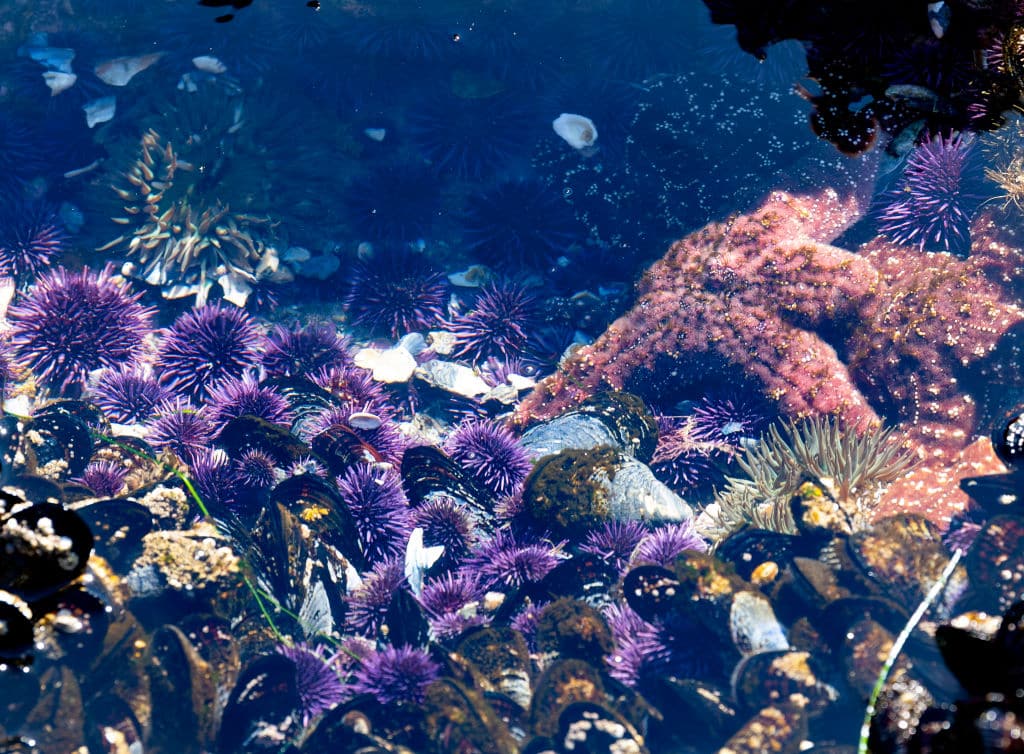
Plastics Solutions
Individuals and organizations are working to clean up the massive amounts of plastic waste in the ocean. There’s a lot of work to be done in this regard, and it can be a challenge to figure out how to handle plastics deep in the ocean or microplastics, which are plastics that have broken into tiny pieces.
Fishing gear is a major risk to marine life, but a recent study found that using LED-illuminated gillnets was successful in reducing accidental bycatch incidences.
Boyan Slat is one such individual who has made international headlines for ocean plastics solutions. Slat founded The Ocean Cleanup with the mission to clean up the Great Pacific Garbage Patch. The nonprofit is creating innovative technologies, like the System 002, to reach a goal of reducing floating ocean plastics by 90% by 2040. The organization has also created Interceptors to collect plastics in rivers, since its own research found that over 80% of riverine pollution comes from 1,000 rivers.
Similarly, Plastic Fischer created a simple device called the TrashBoom that floats in rivers and collects plastic waste as it floats downstream to keep that waste from flowing into the ocean in the first place. The design is open source, so anyone can make their own TrashBooms to help collect river waste.
What You Can Do to Fight Against Ocean Degradation
Certainly, governments, corporations and industries need to implement and enforce stricter ocean conservation measures to protect the ocean, and environmental organizations can continue their work in restoring and preserving marine environments and their unique biodiversity. But there are some actions you can take as an individual to make a difference.
First, vote. Vote for representatives that have the environment in their best interest, and make sure to look into where these candidates receive campaign funding from. Some may claim to be in favor of marine conservation while being bankrolled by the fossil fuel industry.
You can also make a difference with where you spend your dollars. From supporting sustainable brands to donating to nonprofit organizations working on marine conservation, where you spend and don’t spend your money can show companies and organizations what is most important to consumers.
At home, reducing waste, especially plastic waste, is important. Even though people aren’t generally throwing their trash into the ocean directly, this waste can end up in the ocean anyway. Instead, focus on reusable items as much as possible.
If you eat seafood, make sure you choose sustainable seafood options using the handy consumer information from Monterey Bay Aquarium’s Seafood Watch or the Marine Stewardship Council.
Takeaway
Thinking about big topics like climate change or pollution in the depths of the sea feels daunting. Truthfully, cleaning up and preserving marine environments are big, important tasks. But those tasks fall on all of us: individuals, governments, companies, nonprofit organizations.
Together, we can reduce the amount of waste we generate while also cleaning up the existing waste plaguing the oceans. Together, we can work to curb emissions to lessen sea level rise, ocean warming and acidification.
One day, the ocean can be a more habitable environment for all the unique and aquatic creatures and plants while also being a safe place for humans to enjoy recreationally. But that’s only with swift, large-scale actions. Human life depends on healthy oceans, so we must act now for a better future for oceans — and life on Earth.
